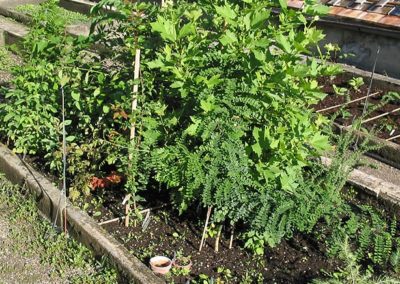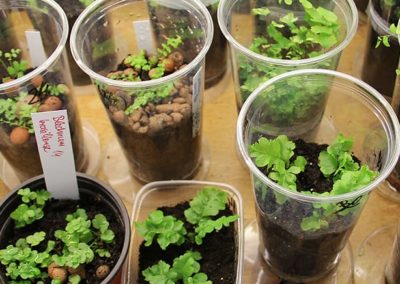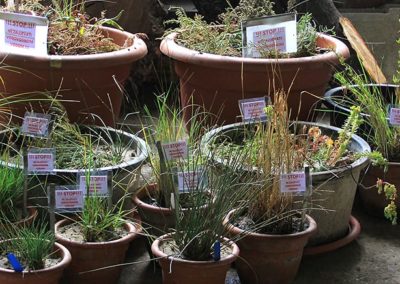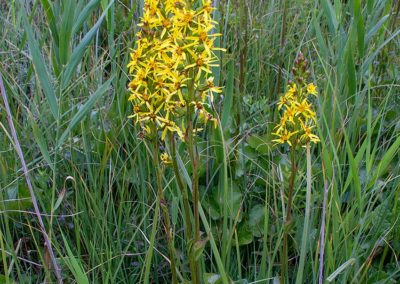

Cultivation of plants for the Collection
We already described our Collection, as well as the value of plant species belonging to Croatian flora. How do we obtain those plants, where from do they arrive and how much time and effort is needed for their cultivation? Most of allochthonous (foreign, exotic) plants in the greenhouses, the arboretum and flower beds were propagated from seeds. Only a small number of specimens were obtained as a gift from other botanic gardens or private individuals, and occasionally we may buy grafted cultivars of trees, shrubs, as well as annuals. The process of cultivation from seeds is generally slow and long; each year we exchange seed catalogues (Index seminum or Delectus seminum) with numerous botanic gardens all over the world. We offer our seeds and order plant material from their catalogues (mostly just seeds, but sometimes also bulbs, tubers and cuttings). It is a great way of enriching a gardens plant collection for free, and one with a 100-year tradition. This exchange is available only for institutional botanic gardens, not private individuals or for commercial purposes. The seeds are dispatched in January and February, when we also receive seeds ordered from other botanic gardens. Seeds are usually sown right upon their arrival, after studying the best condition for germination, such as light and temperature requirement, as well as special treatments, e.g. chilling (stratification), mechanical or chemical scarification, smoke treatment etc. While most seeds are easy to germinate, others take a long time and a lot of care. After germination, seedlings are re-potted several times and after reaching the right size, they are transferred to appropriate greenhouse or cultivation flower bed. The specimen must be checked (determined) to confirm it is indeed the plant ordered from catalogue; it can happen the plant is not a ‘clean’ species but a hybrid, because many seeds are the result of open pollination in garden collections. In that sense, most valuable are the seeds collected from wild populations. After the check-up the plant is permanently enlisted in the garden database with all the possible information on its origin, and it is adequately labelled.
Cultivation of many plants is a ‘tricky’ process, with importance of following precise protocols and ensuring specific growing conditions. Such are the ferns, which are cultivated from spores (if vegetative cultivation is not available). The spore will germinate into a small prothalium (first, gametophyte stage) only if the right temperature, light, humidity and soil pH ratios are achieved. Development of a young fern (sporophyte) from the prothallium can take weeks and even months, often in different conditions compared to those required for spore germination. We are cultivating ferns in a small laboratory, preparing a larger collection for the ‘shaded house’ – part of the old exhibition greenhouse currently in restoration, interesting species such as Java staghorn fern (Platycerium willnicki), Oriental woodwardia (Woodwardia orientalis) and Brazilian dwarf tree fern (Blechnum brasiliense).
On the basis of differences and shared characteristics, all biological organisms, including plants, are named and grouped together into taxa (singular: taxon) and these groups are given a taxonomic rank. Scientific discipline in charge of this is called taxonomy. The basic unit of biological classification and a taxonomic rank, as well as a unit of biodiversity is a SPECIES. There are also different sub-rank categories, such as subspecies, variety and form. Those are all ‘natural’ categories, i.e. appearing spontaneously in wild. Opposite to those categories are plants ‘designed’ through selection, cross pollination, genetic engineering etc., called CULTIVARS. They are selected for desirable characters that are maintained during propagation, such as size, shape, colour, odour of flowers, leaves and fruits. Cultivar name is composed of botanical name of the plant and the cultivar epithet, which is written in non-italicized, capitalized words in single quotes – e.g. Abies alba ‘Pendula’ is a ‘weeping’ cultivar of European fir.
The term ‘taxa’ is used to describe any plant without specifying the exact rank (species and infraspecific categories, as well as cultivars). For instance, Croatian flora numbers 4536 taxa, including all the wild species, subspecies, varieties and forms.
Ex situ conservation of Croatian flora through licensed cultivation
Our native plants collection is of special value to the Garden, at present containing approximately one fourth of Croatian flora. Most important are the rare and endangered statutorily protected plants, most importantly endemic plants. We cultivate them in different places in the Garden, with majority growing in the phytogeographic vegetation beds or the ‘rockeries’:croatian-flora
The plants are grown from seeds or cultivated from cuttings and live specimens collected in natural habitats during regular field-trips around Croatia. Collecting plant material from the wild is licensed by the Ministry and the Croatian agency for environment and nature. Our goal is not only to collect and grow as many plants of Croatian flora for the public display in the Garden, but also to establish small ex situ populations which could serve as propagation stock plants. From such plants an ex situ population is maintained for years, even decades, and the surplus specimens are sold to visitors. The best example of such practice is licensed cultivation and sale of the most famous Croatian endemic plant, the Velebit degenia (Degenia velebitica). croatian-flora
Number of seeds to be collected is strictly determined in the permit issued by Croatian agency for environment and nature
Other than statutorily protected plants, we also cultivate those recognized by other protection levels, such as their status in the Red book of vascular flora of Croatia and the Natura 2000 ecology network. During field monitoring of protected plants program we collect seeds to be used in germination ecology research, and plants that are grown from the seeds are planted into field test-beds. For a small number of specimens a sale license is acquired and the plants are offered to the public. At present we are investigating the following species (with their location in the Garden): Ladybells (Adenophora liliifolia) – P32, Big-leaf ligularia (Ligularia sibirica) – P32, Dalmatian scilla (Scilla litardierei) – Sp, Velebit degenia (Degenia velebitica) – M2, K, Single-flowered saw wort (Serratula lycopifolia) – Sp and a Mediterranean species of broom (Genista holopetala).






















